Papers by Angelo Montanari

Logical Methods in Computer Science, 2022
The expressive power of interval temporal logics (ITLs) makes them one of the most natural choice... more The expressive power of interval temporal logics (ITLs) makes them one of the most natural choices in a number of application domains, ranging from the specification and verification of complex reactive systems to automated planning. However, for a long time, because of their high computational complexity, they were considered not suitable for practical purposes. The recent discovery of several computationally well-behaved ITLs has finally changed the scenario. In this paper, we investigate the finite satisfiability and model checking problems for the ITL D, that has a single modality for the sub-interval relation, under the homogeneity assumption (that constrains a proposition letter to hold over an interval if and only if it holds over all its points). We first prove that the satisfiability problem for D, over finite linear orders, is PSPACE-complete, and then we show that the same holds for its model checking problem, over finite Kripke structures. In such a way, we enrich the se...
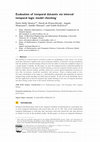
The problem of temporal dataset evaluation consists in establishing to what extent a set of tempo... more The problem of temporal dataset evaluation consists in establishing to what extent a set of temporal data (histories) complies with a given temporal condition. It presents a strong resemblance with the problem of model checking enhanced with the ability of rating the compliance degree of a model against a formula. In this paper, we solve the temporal dataset evaluation problem by suitably combining the outcomes of model checking an interval temporal logic formula against sets of histories (finite interval models), possibly taking into account domain-dependent measures/criteria, like, for instance, sensitivity, specificity, and accuracy. From a technical point of view, the main contribution of the paper is a (deterministic) polynomial time algorithm for interval temporal logic model checking over finite interval models. To the best of our knowledge, this is the first application of a (truly) interval temporal logic model checking in the area of temporal databases and data mining rath...
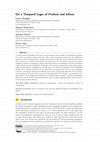
A classic result by Stockmeyer [16] gives a non-elementary lower bound to the emptiness problem f... more A classic result by Stockmeyer [16] gives a non-elementary lower bound to the emptiness problem for star-free generalized regular expressions. This result is intimately connected to the satisfiability problem for interval temporal logic, notably for formulas that make use of the so-called chop operator. Such an operator can indeed be interpreted as the inverse of the concatenation operation on regular languages, and this correspondence enables reductions between non-emptiness of star-free generalized regular expressions and satisfiability of formulas of the interval temporal logic of the chop operator under the homogeneity assumption [5]. In this paper, we study the complexity of the satisfiability problem for a suitable weakening of the chop interval temporal logic, that can be equivalently viewed as a fragment of Halpern and Shoham interval logic featuring the operators B, for “begins”, corresponding to the prefix relation on pairs of intervals, and D, for “during”, corresponding ...
The paper “Proposed Temporal Database Concepts— May 1993” contained a complete set of glossary en... more The paper “Proposed Temporal Database Concepts— May 1993” contained a complete set of glossary entries proposed by members of the temporal database community from Spring 1992 until May 1993. The aim of the proposal was to define a consensus glossary of temporal database concepts and names. Several glossary entries (Section 3) were included in the proposal, but were still unresolved at the time of the deadline. This addendum reflects on-going discussions and contains revised versions of several unresolved entries. The entries here thus supersede the corresponding entries in Section 3 of the proposal.
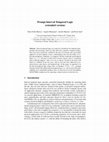
Interval temporal logics are expressive formalisms for temporal representation and reasoning, whi... more Interval temporal logics are expressive formalisms for temporal representation and reasoning, which use time intervals as primitive temporal entities. They have been extensively studied for the past two decades and successfully applied in AI and computer science. Unfortunately, they lack the ability of expressing promptness conditions, as it happens with the commonly-used temporal logics, e.g., LTL: whenever we deal with a liveness request, such as “something good eventually happens”, there is no way to impose a bound on the delay with which it is fulfilled. In the last years, such an issue has been addressed in automata theory, game theory, and temporal logic. In this paper, we approach it in the interval temporal logic setting. First, we introduce PROMPT-PNL, a prompt extension of the well-studied interval temporal logic PNL, and we prove the undecidability of its satisfiability problem; then, we show how to recover decidability (NEXPTIME-completeness) by imposing a natural syntac...

Model checking is one of the most powerful and widespread tools for system verification with appl... more Model checking is one of the most powerful and widespread tools for system verification with applications in many areas of computer science and artificial intelligence. The large majority of model checkers deal with properties expressed in point-based temporal logics, such as LTL and CTL. However, there exist relevant properties of systems which are inherently interval-based. Model checking algorithms for interval temporal logics (ITLs) have recently been proposed to check interval properties of computations. As the model checking problem for full Halpern and Shoham's ITL (HS for short) turns out to be decidable, but computationally heavy, research has focused on its well-behaved fragments. In this paper, we provide an almost final picture of the computational complexity of model checking for HS fragments with modalities for (a subset of) Allen's relations meets, met by, starts, and ends.

Since the late 80s, LTL and CTL model checking have been extensively applied in various areas of ... more Since the late 80s, LTL and CTL model checking have been extensively applied in various areas of computer science and AI. Even though they proved themselves to be quite successful in many application domains, there are some relevant temporal conditions which are inherently “interval based” (this is the case, for instance, with telic statements like “the astronaut must walk home in an hour” and temporal aggregations like “the average speed of the rover cannot exceed the established threshold”) and thus cannot be properly modelled by point-based temporal logics. In general, to check interval properties of the behavior of a system, one needs to collect information about states into behavior stretches, which amounts to interpreting each finite sequence of states as an interval and to suitably defining its labelling on the basis of the labelling of the states that compose it. In order to deal with these properties, a model checking framework based on Halpern and Shoham’s interval tempora...

In the last years, various meaningful extensions of ω-regular languages have been proposed in the... more In the last years, various meaningful extensions of ω-regular languages have been proposed in the literature, including ωB-regular languages (ω-regular languages extended with boundedness), ωS-regular languages (ω-regular languages extended with strict unboundedness), and ωBS-regular languages, which are obtained from the combination of ωBand ωS-regular languages. However, while its components satisfy a generalized closure property, namely, the complement of an ωB-regular (resp., ωS-regular) language is an ωS-regular (resp., ωB-regular) one, the class of ωBS-regular languages is not closed under complementation. The existence of non-ωBS-regular languages that are the complements of some ωBS-regular ones and express fairly natural properties of reactive systems motivates the search for larger, well-behaved classes of extended ω-regular languages. In this paper, we introduce the class of ωT -regular languages, that captures meaningful languages not belonging to the class of ωBS-regula...
In this paper, we deal with the ultimately-periodic finite interval temporal logic model checking... more In this paper, we deal with the ultimately-periodic finite interval temporal logic model checking problem. The problem has been shown to be in PTIME for full Halpern and Shoham’s interval temporal logic (HS for short) over finite models, as well as for the HS fragment featuring a modality for Allen relation meets and metric constraints over non-sparse ultimately-periodic (finite) models, that is, over ultimately-periodic models whose representation is polynomial in their size. Here, we generalize the latter result to the case of sparse ultimately-periodic models.
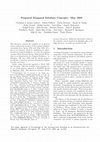
This document contains the complete set of glossary entries proposed by members of the temporal d... more This document contains the complete set of glossary entries proposed by members of the temporal database community from Spring 1992 until May 1993. It is part of an initiative aimed at establishing an infrastructure for temporal databases. As such, the proposed concepts will be discussed during “International Workshop on an Infrastructure for Temporal Databases,” in Arlington, TX, June 1993, with the specific purpose of defining a consensus glossary of temporal database concepts and names. Earlier status documents appeared in March 1993 and December 1992 and included terms proposed after an initial glossary appeared in SIGMOD Record in September 1992. This document subsumes all the ∗Correspondence may be directed to the TSQL electronic mail distribution, tsql@cs.arizona.edu, or to the editor at Aalborg University, Datalogi, Fr. Bajers Vej 7E, DK–9220 Aalborg Ø, Denmark, csj@iesd.auc.dk. Affiliations and e-mail addresses of the authors follow. J. Clifford, Information Systems Dept., ...
In this paper, we introduce a new class of automata over infinite words (counter-queue automata) ... more In this paper, we introduce a new class of automata over infinite words (counter-queue automata) and we prove the decidability of their emptiness problem. Then, we define an original extension of ωregular languages, called ωT-regular languages, that captures meaningful languages that neither belong to the class of ω-regular languages nor to other extensions of it proposed in the literature, and we show that counter-queue automata are expressive enough to encode them. ‹ D. Della Monica acknowledges the financial support from a Marie Curie INdAM-COFUND-2012 Outgoing Fellowship. A. Montanari acknowledges the support from the Italian GNCS Project "Logics and Automata for Interval Model Checking".
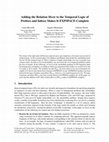
Electronic Proceedings in Theoretical Computer Science, 2021
The choice of the right trade-off between expressiveness and complexity is the main issue in inte... more The choice of the right trade-off between expressiveness and complexity is the main issue in interval temporal logic. In their seminal paper [10], Halpern and Shoham showed that the satisfiability problem for HS (the temporal logic of Allen's relations) is highly undecidable over any reasonable class of linear orders. In order to recover decidability, one can restrict the set of temporal modalities and/or the class of models. In the following, we focus on the satisfiability problem for HS fragments under the homogeneity assumption, according to which any proposition letter holds over an interval if only if it holds at all its points. The problem for full HS hom has been shown to be non-elementarily decidable [13], but its only known lower bound is EXPSPACE (in fact, EXPSPACE-hardness has been shown for the logic of prefixes and suffixes BE hom , which is a very small fragment of it [3]). The logic of prefixes and infixes BD hom has been recently shown to be PSPACE-complete [5]. In this paper, we prove that the addition of the Allen relation Meets to BD hom makes it EXPSPACE-complete.
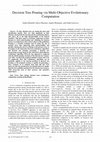
International Journal of Machine Learning and Computing, 2017
To date, decision trees are among the most used classification models. They owe their popularity ... more To date, decision trees are among the most used classification models. They owe their popularity to their efficiency during both the learning and the classification phases and, above all, to the high interpretability of the learned classifiers. This latter aspect is of primary importance in those domains in which understanding and validating the decision process is as important as the accuracy degree of the prediction. Pruning is a common technique used to reduce the size of decision trees, thus improving their interpretability and possibly reducing the risk of overfitting. In the present work, we investigate on the integration between evolutionary algorithms and decision tree pruning, presenting a decision tree post-pruning strategy based on the well-known multi-objective evolutionary algorithm NSGA-II. Our approach is compared with the default pruning strategies of the decision tree learners C4.5 (J48-on which the proposed method is based) and C5.0. We empirically show that evolutionary algorithms can be profitably applied to the classical problem of decision tree pruning, as the proposed strategy is capable of generating a more variegate set of solutions than both J48 and C5.0; moreover, the trees produced by our method tend to be smaller than the best candidates produced by the classical tree learners, while preserving most of their accuracy and sometimes improving it.

Theoretical Computer Science, 2020
In the last years, some extensions of ω-regular languages, namely, ωB-regular (ω-regular language... more In the last years, some extensions of ω-regular languages, namely, ωB-regular (ω-regular languages extended with boundedness), ωS-regular (ω-regular languages extended with strong unboundedness), and ωBS-regular languages (the combination of ωB-and ωS-regular ones), have been proposed in the literature. While the first two classes satisfy a generalized closure property, which states that the complement of an ωB-regular (resp., ωS-regular) language is an ωS-regular (resp., ωB-regular) one, the last class is not closed under complementation. The existence of non-ωBS-regular languages that are the complements of some ωBS-regular ones and express fairly natural asymptotic behaviors motivates the search for other significant classes of extended ω-regular languages. In this paper, we present the class of ωT-regular languages, which includes meaningful languages that are not ωBS-regular. We define this new class of languages in terms of ωT-regular expressions. Then, we introduce a new class of automata (counter-check automata) and we prove that (i) their emptiness problem is decidable in PTIME, and (ii) they are expressive enough to capture ωT-regular languages. We also provide an encoding of ωT-regular expressions into S1S+U. Finally, we investigate a stronger variant of ωT-regular languages (ωT s-regular languages). We characterize the resulting class of languages in terms of ωT s-regular expressions, and we show how to map it into a suitable class of automata, called counter-queue automata. We conclude the paper with a comparison of the expressiveness of ωT-and ωT s-regular languages and of the $ This paper is an extended and merged version of [1] and [2]. Part of the work was done while A. Montanari was visiting the Universidad Complutense de Madrid. The work was supported by the Italian INdAM-GNCS project Formal methods for the verification and synthesis of discrete and hybrid systems. D. Della Monica acknowledges the financial support from a Marie Curie INdAM-COFUND-2012 Outgoing Fellowship.
Information and Computation, 2019
Interval temporal logics provide a natural framework for temporal reasoning about interval struct... more Interval temporal logics provide a natural framework for temporal reasoning about interval structures over linearly ordered domains, where intervals are taken as first-class citizens. Their expressive power and computational behaviour mainly depend on two parameters: the set of modalities they feature and the linear orders over which they are interpreted. In this paper, we consider all fragments of Halpern and Shoham's interval temporal logic HS with a decidable satisfiability problem over the rationals, and we provide a complete classification of them in terms of their expressiveness and computational complexity by solving the last few open problems.
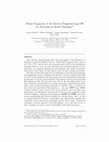
Theoretical Computer Science, 2019
Since the 80's, model checking (MC) has been applied to the automatic verification of hardware/so... more Since the 80's, model checking (MC) has been applied to the automatic verification of hardware/software systems. Point-based temporal logics, such as LTL, CTL, CTL * , and the like, are commonly used in MC as the specification language; however, there are some inherently interval-based properties of computations, e.g., temporal aggregations and durations, that cannot be properly dealt with by these logics, as they model a state-by-state evolution of systems. Recently, an MC framework for the verification of interval-based properties of computations, based on Halpern and Shoham's interval temporal logic (HS, for short) and its fragments, has been proposed and systematically investigated. In this paper, we focus on the boundaries that separate tractable and intractable HS fragments in MC. We first prove that MC for the logic BE of Allen's relations started-by and finished-by is provably intractable, being Expspace-hard. Such a lower bound immediately propagates to full HS. Then, in contrast, we show that other noteworthy HS fragments, i.e., the logic AABB (resp., AAEE) of Allen's relations meets, met-by, starts (resp., finishes), and started-by (resp., finished-by), are well-behaved, and turn out to have the same complexity as LTL (Pspace-complete). Halfway are the fragments AABBE and AAEBE, whose Expspace membership and Pspace hardness are already known. Here, we give an original proof of Expspace membership, that substantially simplifies the complexity of the constructions previously used for such a result. Contraction techniques-suitably tailored to each HS fragment-are at the heart of our results, enabling us to prove a pair of remarkable small-model properties. $ This paper gives an organic and systematic account of the results originally presented in the conference papers [6] and [7].
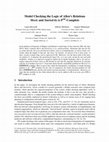
Electronic Proceedings in Theoretical Computer Science, 2016
In the plethora of fragments of Halpern and Shoham's modal logic of time intervals (HS), the logi... more In the plethora of fragments of Halpern and Shoham's modal logic of time intervals (HS), the logic AB of Allen's relations Meets and Started-by is at a central position. Statements that may be true at certain intervals, but at no sub-interval of them, such as accomplishments, as well as metric constraints about the length of intervals, that force, for instance, an interval to be at least (resp., at most, exactly) k points long, can be expressed in AB. Moreover, over the linear order of the natural numbers N, it subsumes the (point-based) logic LTL, as it can easily encode the next and until modalities. Finally, it is expressive enough to capture the ω-regular languages, that is, for each ωregular expression R there exists an AB formula ϕ such that the language defined by R coincides with the set of models of ϕ over N. It has been shown that the satisfiability problem for AB over N is EXPSPACE-complete. Here we prove that, under the homogeneity assumption, its model checking problem is ∆ p 2 = P NP-complete (for the sake of comparison, the model checking problem for full HS is EXPSPACE-hard, and the only known decision procedure is nonelementary). Moreover, we show that the modality for the Allen relation Met-by can be added to AB at no extra cost (AAB is P NP-complete as well).
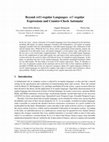
Electronic Proceedings in Theoretical Computer Science, 2017
In the last years, various extensions of ω-regular languages have been proposed in the literature... more In the last years, various extensions of ω-regular languages have been proposed in the literature, including ωB-regular (ω-regular languages extended with boundedness), ωS-regular (ω-regular languages extended with strict unboundedness), and ωBS-regular languages (the combination of ωBand ωS-regular ones). While the first two classes satisfy a generalized closure property, namely, the complement of an ωB-regular (resp., ωS-regular) language is an ωS-regular (resp., ωB-regular) one, the last class is not closed under complementation. The existence of non-ωBS-regular languages that are the complements of some ωBS-regular ones and express fairly natural properties of reactive systems motivates the search for other well-behaved classes of extended ω-regular languages. In this paper, we introduce the class of ωT-regular languages, that includes meaningful languages which are not ωBS-regular. We first define it in terms of ωT-regular expressions. Then, we introduce a new class of automata (counter-check automata) and we prove that (i) their emptiness problem is decidable in PTIME and (ii) they are expressive enough to capture ωT-regular languages (whether or not ωT-regular languages are expressively complete with respect to counter-check automata is still an open problem). Finally, we provide an encoding of ωT-regular expressions into S1S+U.
Logical Methods in Computer Science, 2015
We introduce a modal logic, called Cone Logic, whose formulas describe properties of points in th... more We introduce a modal logic, called Cone Logic, whose formulas describe properties of points in the plane and spatial relationships between them. Points are labelled by proposition letters and spatial relations are induced by the four cone-shaped cardinal directions. Cone Logic can be seen as a weakening of Venema's Compass Logic. We prove that, unlike Compass Logic and other projection-based spatial logics, its satisfiability problem is decidable (precisely, PSPACE-complete). We also show that it is expressive enough to capture meaningful interval temporal logics - in particular, the interval temporal logic of Allen's relations "Begins", "During", and "Later", and their transposes.

Uploads
Papers by Angelo Montanari